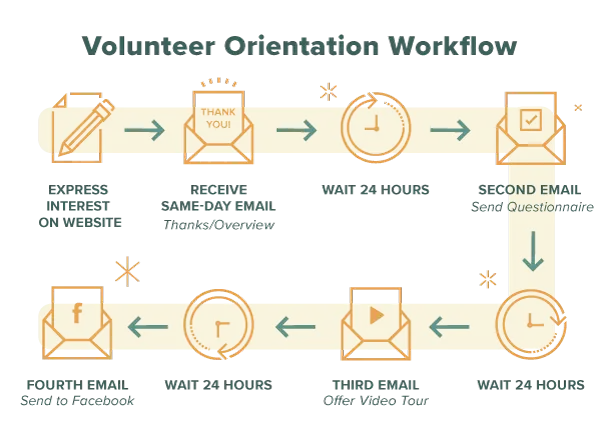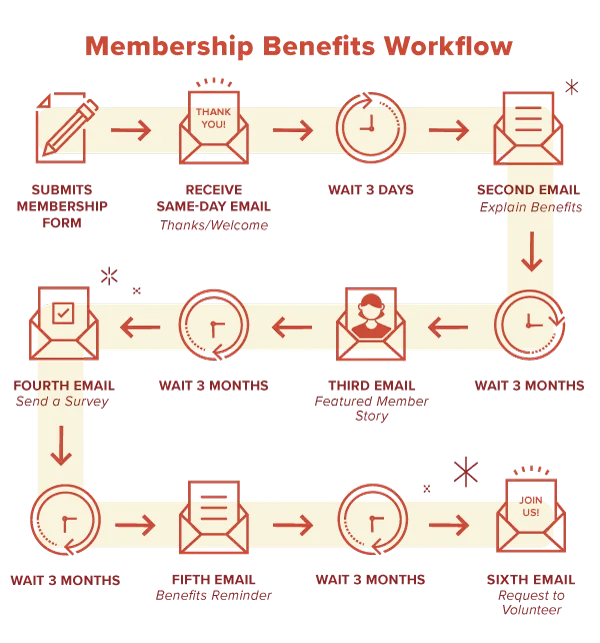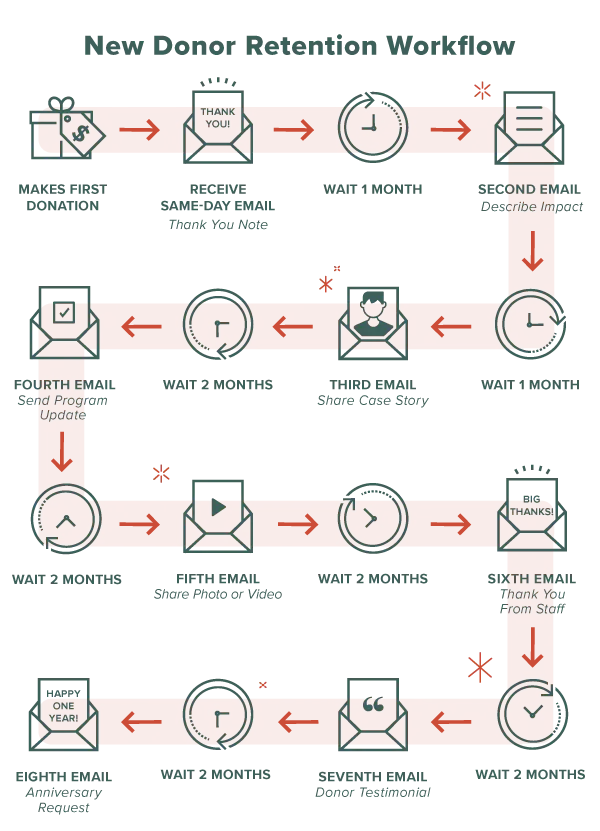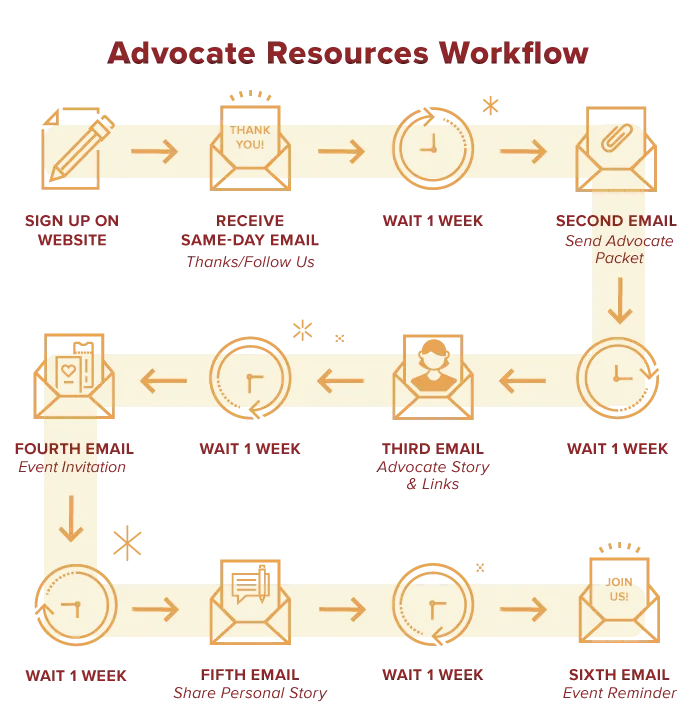Does your organization automatically send a welcome email to people who sign up for your newsletter? Email automation takes many forms, and nonprofit marketers aren’t the only ones who can use automated emails to save time and energy. Volunteer managers, membership coordinators and fundraisers take note!
And if you serve in all of those roles, this post is especially for you.
Using Automation for Onboarding
If you’ve implemented a welcome workflow for your organization, you know that it’s an easy way to stay top of mind and introduce people to your mission and programs. Whether someone signed up on your website or on a clipboard at a community event, automated welcome messages can be the first step to building a relationship.
But there’s more…
Email automation can be used to help with other areas of onboarding at your nonprofit, like volunteer orientation or advocacy training. When someone is new to your organization, or just new to an area of your work, email automation offers some great benefits:
- You can strategically send them important messages at the right time, in the right order.
- They receive more consistent touch points from your organization thanks to pre-planning.
- The emails can offer content that’s uniquely relevant to their interests and situation.
- You can track overall engagement (looking at the click and open rates) and adjust the emails as needed over time.
Plus, you can feel a little less guilty if you don’t have time to reach out on the regular.
To take advantage of these perks, it’s important to map out your automated workflows in advance, from start to finish. For each workflow, you (or a colleague) should be able to answer five key questions.
- What’s the goal?
- Who gets the emails?
- When will the emails send?
- Who’s sending the emails?
- How will you engage?
We wrote more about these questions and how to answer them in a previous post. We also created a free planning template that can help you stay organized and collect the details for a new email automation project.
Download the Email Automation Planner
Get a free template that you can use to map out an automated email campaign. Adjust it to meet your needs and store your content in one place. You can also share it with other staff to help them plan an onboarding email series.
"*" indicates required fields
Email Workflow Examples
To show you how automation can be used to onboard different audiences, we’ve outlined four hypothetical workflows with suggested goals, email content and timing. Use them to spark your imagination and identify areas of your nonprofit’s work that could benefit from similar campaigns.
Volunteer Orientation Workflow
An animal rescue organization uses their website as a way to recruit new volunteers for their shelter. To help people better understand the commitment required, the volunteer coordinator would like for them to do some training before they come in for their first shift. The goal of the workflow will be to get volunteers to complete an online orientation.
Audience
Once someone signs up using the online form, the organization’s email marketing service will be triggered to add them to the volunteer workflow.
Email Content
The workflow includes four emails over the course of a week.
- Message of thanks and a brief overview of the organization’s mission and impact
- Questionnaire about the volunteer’s skills and abilities
- Pre-recorded video tour of the shelter with the volunteer coordinator
- Invitation to join the organization’s Facebook Group for volunteers, where upcoming volunteer shifts are announced.
Timing
The first email is sent immediately, and the remaining emails are sent out 1/day until they are done. If someone unsubscribes over the course of the workflow, or if they don’t click to watch the video in the third email, they won’t receive the final email with next steps.

Membership Benefits Workflow
A well-established membership organization for health professionals wants to make sure that their new members feel welcomed and see the ongoing value of joining. While the nonprofit regularly sends out newsletters, they’ve gotten feedback that new members often feel like outsiders. The ultimate goal of the membership workflow is to motivate new members to volunteer as a committee member, event host or mentor.
Audience
A person is added to the workflow once they submit the membership form on the website. Alternatively, the membership manager can manually add someone to the queue.
Email Content
The workflow contains six emails over the course of a year.
- Welcome message and introduction to the member community
- Explanation of key member benefits
- Member story that illustrates the impact of the association
- Survey about professional development interests
- Reminder about member benefits (or announce new ones)
- Request to become a volunteer with the association
Timing
The first email is sent immediately, followed by the second email three days later. After that, the remaining messages are on a schedule of one email per quarter.

New Donor Retention Workflow
A local chapter of a national nonprofit has been successful at attracting new donors when mission-related issues are in the news. (Rage donations, anyone?) However, their retention rate is low as they struggle to get these new supporters to give again. The goal of the donor retention workflow will be to keep their cause top of mind and encourage first-time donors to give again by the next year.
Audience
A donor is added to the workflow when they give through the organization’s online donation form for the first time and are also new to the mailing list. Anyone signing up for monthly giving would be excluded.
Email Content
The workflow includes eight emails over the course of a year.
- Thank you message from the executive director
- Description of the organization’s impact to date
- Case story from someone the group has helped
- Program update outlining the highest priorities
- Inspiring photo or video clip from the community
- Thank you note from a staff member
- Donor testimonial about why they give
- One-year anniversary message with a request to continue their support
Timing
The first email is sent immediately, and the next two emails are spread out over the next two months. The remaining emails are scheduled to send once every two months until the anniversary date.

Advocate Resources Workflow
An environmental nonprofit wants to build support for new legislation that would reduce pollution in their constituents’ neighborhoods. In addition to asking their supporters to contact public officials and write letters to the editors of local newspapers, the nonprofit is organizing a day of advocacy at the state legislature. The goal of the advocate resources workflow is to encourage people who are new to advocacy to attend the event a few months from now.
Audience
Anyone who submits the “become an advocate” form on the organization’s website starts the email automation.
Email Content
The workflow includes six emails over the course of 6 weeks.
- Thank you message from the policy director with a request to follow the organization and a specific hashtag on social media.
- Downloadable “Get Started” packet with background materials and ideas for local events
- Featured advocate story with links to blog posts about other successful advocates
- Motivational message with an invitation to participate in the advocacy event
- Personal story from an impacted resident
- Reminder email about the upcoming event and to register now
Timing
The first email is sent immediately, with the remaining emails sent once per week.

Automation Tips for Mailchimp Users
We typically recommend Mailchimp for nonprofits, and that’s especially true when it comes to creating automated emails. If you’re already using Mailchimp and want to do more with automation, here are a few extra tips based on our work with nonprofit clients.
- It’s easier to build and manage automated campaigns when your account is set up using a master list with groups. For additional segmentation, there are lots of possibilities using the newly unveiled tagging option.
- You can always pause or edit emails in an automation, and you can add new emails to the queue over time. (Newly added emails will also be sent to anyone who completed the workflow in the past.)
- It’s possible to segment subscribers in an automated campaign based on their activity. For example, if someone who’s receiving the welcome workflow makes a donation, they could stop receiving the welcome series and start a workflow for donors instead.
- You can create post-sending actions that add subscribers to a specific group or tag when they complete the workflow. For example, a volunteer who completes an orientation workflow could be tagged as “Completed Orientation.” When you want to announce a new volunteer opportunity, you could restrict your mailing list to subscribers with that tag.
Onboarding new people can take a lot of time and attention, even when the information is largely the same for each individual. Consider using email automation to help standardize the process as you work to build lasting relationships in-person and online. We think you’ll love it so much that the biggest problem will be the line of people at your desk asking to use it, too.
Do you see the potential for automated emails in your onboarding processes? What other types of workflows should nonprofits consider? I’d love to hear your thoughts and any questions about automation in the comments.
What You Should Do Now
01. Come to Nonprofit Website Office Hours
We cover a new topic every few weeks. Plus get a live answer to any website-related question you're wrestling with.
02. Book a Website Call
Find a time to discuss your nonprofit's website needs. Discover what's worked for other nonprofits like you and see how easy building your new site can be.
03. Start a Free Website Trial
Try our nonprofit website platform for yourself. Instantly get access to every feature to see if it's the right fit for your needs. No credit card required.

Comments